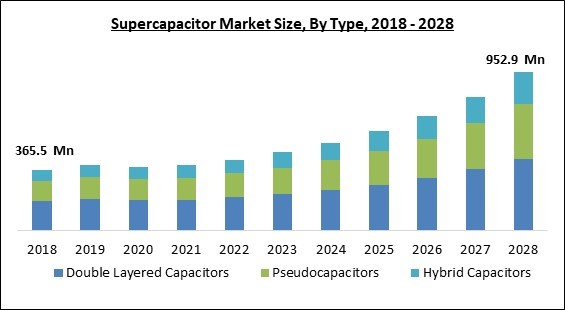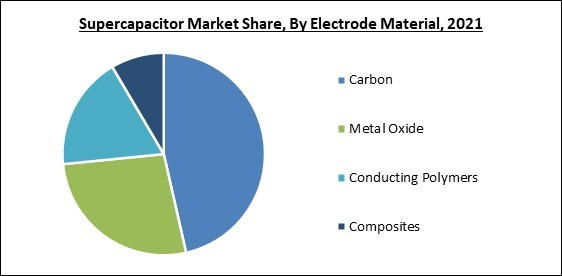The Global Supercapacitor Market size is expected to reach $952.9 Million by 2028, rising at a market growth of 14.3% CAGR during the forecast period.
The energy is stored and released through reversible ion adsorption and desorption at interfaces between electrode materials & electrolytes in a supercapacitor, which is an electrochemical energy storage device. Supercapacitors, often referred to as ultracapacitors, are utilized for quick charge and discharge since they have negligible resistance and can store 10 to 100 times the power of conventional electrolytic capacitors.
In the electronic device taxonomy, these fall into the capacitor and battery categories and are used to complement conventional batteries, which can also be utilized as a short-term backup power source because supercapacitor circuits support continuous power supply. The accelerated use of supercapacitors for EVs/HEVs, trains & aircraft, wind turbines, smart wearables, grid energy storage systems, and rail wayside are some of the major factors driving the growth of the supercapacitor market. These applications are especially in the automotive, energy, and consumer electronics industries.
A supercapacitor is a cutting-edge energy storage device that can offer greater power density than batteries & greater energy density than conventional capacitors. Solar illumination and solar PV panels are two potential applications for supercapacitors. Additionally, supercapacitors are dependable choices for solar panels because they are employed in both online and offline modes. The importance of environmental friendliness has raised users of energy storage equipment's awareness of the need to reduce emissions.
Major corporations are stepping up their efforts to cut greenhouse gas emissions, and market trends point to an increase in demand for alternative energy sources. An electrochemical double-layer capacitor's components are all made of easily biodegradable carbon in some way. The surge in the adoption of supercapacitors in automotive applications is a key element propelling the supercapacitor market's expansion. Supercapacitors are suitable for use in automotive applications due to a number of factors, including their high power density, long shelf life, & quick charging capabilities.
The market research report covers the analysis of key stake holders of the market. Key companies profiled in the report include Panasonic Corporation, Eaton Corporation PLC, Cornell Dubilier Electronics, Inc., CAP-XX Ltd, Nippon Chemi-Con Corp., Ioxus (XS Power Batteries), Kilowatt labs, Inc., Targray Technology International Inc., and Skeleton Technologies.
The energy is stored and released through reversible ion adsorption and desorption at interfaces between electrode materials & electrolytes in a supercapacitor, which is an electrochemical energy storage device. Supercapacitors, often referred to as ultracapacitors, are utilized for quick charge and discharge since they have negligible resistance and can store 10 to 100 times the power of conventional electrolytic capacitors.
In the electronic device taxonomy, these fall into the capacitor and battery categories and are used to complement conventional batteries, which can also be utilized as a short-term backup power source because supercapacitor circuits support continuous power supply. The accelerated use of supercapacitors for EVs/HEVs, trains & aircraft, wind turbines, smart wearables, grid energy storage systems, and rail wayside are some of the major factors driving the growth of the supercapacitor market. These applications are especially in the automotive, energy, and consumer electronics industries.
A supercapacitor is a cutting-edge energy storage device that can offer greater power density than batteries & greater energy density than conventional capacitors. Solar illumination and solar PV panels are two potential applications for supercapacitors. Additionally, supercapacitors are dependable choices for solar panels because they are employed in both online and offline modes. The importance of environmental friendliness has raised users of energy storage equipment's awareness of the need to reduce emissions.
Major corporations are stepping up their efforts to cut greenhouse gas emissions, and market trends point to an increase in demand for alternative energy sources. An electrochemical double-layer capacitor's components are all made of easily biodegradable carbon in some way. The surge in the adoption of supercapacitors in automotive applications is a key element propelling the supercapacitor market's expansion. Supercapacitors are suitable for use in automotive applications due to a number of factors, including their high power density, long shelf life, & quick charging capabilities.
COVID-19 Impact Analysis
The market suffered in 2020 in all areas; however, with the economic recovery, the market has gained some pace. Power recovery & dynamic brake energy storage are two of the principals uses of supercapacitors in the automotive sector. It is predicted that the COVID-19 pandemic will have an impact on shared mobility services and public transit. This is anticipated to have an effect on both the production of cars and the market for supercapacitors. The digital economic revolution is also having an influence on the electrical sector as a result of the COVID-19 outbreak.Market Growth Factors
Increasing Use In Renewable Energy Production Facilities
The construction of renewable energy power plants has substantially enhanced across the world as the globe moves toward sustainable energy sources. Supercapacitors are used in a variety of energy storage systems because they can provide higher power and energy densities than batteries and conventional capacitors. For effectively sustaining microgrids, supercapacitors also offer high specific capacitance & electrical stability. Supercapacitors are used primarily by solar and wind power facilities. These capacitors are often utilized to run microgrids that produce renewable energy.Better Alternative To Conventional Batteries
Supercapacitors are able to charge and release energy more quickly than conventional batteries, which carry out the same function much more slowly. These electrode- and electrolyte-equipped capacitors can rapidly charge and discharge over a very large number of cycles, making them an effective replacement for conventional batteries in a variety of applications. The usage of energy storage technology with little or no emissions is becoming more popular among consumers as environmental friendliness gains importance.Market Restraining Factors
Need Consistent Parameter Optimization
Supercapacitors are still in the developmental stages despite being utilized in commercial applications for around 20 years. Because of their high leakage and discharge rates, these capacitors can currently only be employed for short-term, high-energy applications. To ensure their ideal performance, they require regular electrical parameter tuning. As a result, regular maintenance of supercapacitors becomes extremely important. Supercapacitors are also expensive. Supercapacitors require a number of pricey and challenging to obtain materials. Additionally, it is challenging for supercapacitor producers to locate inexpensive electrodes that are extremely efficient.Type Outlook
Based on type, the supercapacitor market is segmented into double layered capacitors, pseudo capacitors and hybrid capacitors. The pseudo capacitors segment acquired a significant revenue share in the supercapacitors market in 2021. These capacitors are used in a variety of battery integration applications to boost power density and improve electrical flow in energy storage systems. The expansion in this segment will be driven by long-standing research and development facilities by major industry players to create pseudo capacitors such as lithium-ion capacitors with the economic viability and improved efficiency.Electrode Material Outlook
On the basis of electrode material, the supercapacitor market is classified into carbon, metal oxide, conducting polymers and composites. The metal oxide segment covered a significant revenue share in the supercapacitor market in 2021. Metal Oxides in supercapacitors discusses the principles of supercapacitors based on metal oxides and gives a rundown of current developments in this field. Due to their outstanding physico-chemical characteristics and stability in electrochemical settings, metal oxides draw the majority of the materials used by scientists.Application Outlook
By application, the supercapacitor market is fragmented into automotive, energy, consumer electronics, industrial, aerospace, medical and others. In 2021, the automotive sector held the highest revenue share in the supercapacitor market. In the automobile industry, the introduction of electric vehicles has raised the demand for supercapacitors. Due to supercapacitors' great scalability and wide working temperature range, many automakers around the world are gradually moving away from battery-powered electric vehicles and toward supercapacitor-powered electric vehicles.Regional Outlook
Region-wise, the supercapacitor market is analyzed across North America, Europe, Asia Pacific, and LAMEA. In 2021, the Asia Pacific region led the supercapacitor market with the highest revenue share. The consumer electronics & automotive industries are expanding quickly in China, which is likely to enhance the demand for supercapacitors there. This expansion is being fueled by rapid infrastructure development and industrialization. Because China is the world's largest producer of low-cost cars, the market for supercapacitors used in the automotive industry is expanding.The market research report covers the analysis of key stake holders of the market. Key companies profiled in the report include Panasonic Corporation, Eaton Corporation PLC, Cornell Dubilier Electronics, Inc., CAP-XX Ltd, Nippon Chemi-Con Corp., Ioxus (XS Power Batteries), Kilowatt labs, Inc., Targray Technology International Inc., and Skeleton Technologies.
Scope of the Study
Market Segments Covered in the Report:
By Type
- Double Layered Capacitors
- Pseudocapacitors
- Hybrid Capacitors
By Application
- Automotive
- Consumer Electronics
- Energy
- Industrial
- Aerospace
- Medical
- Others
By Electrode Material
- Carbon
- Metal Oxide
- Conducting Polymers
- Composites
By Geography
- North America
- US
- Canada
- Mexico
- Rest of North America
- Europe
- Germany
- UK
- France
- Russia
- Spain
- Italy
- Rest of Europe
- Asia Pacific
- China
- Japan
- India
- South Korea
- Singapore
- Malaysia
- Rest of Asia Pacific
- LAMEA
- Brazil
- Argentina
- UAE
- Saudi Arabia
- South Africa
- Nigeria
- Rest of LAMEA
Key Market Players
List of Companies Profiled in the Report:
- Panasonic Corporation
- Eaton Corporation PLC
- Cornell Dubilier Electronics, Inc.
- CAP-XX Ltd
- Nippon Chemi-Con Corp.
- Ioxus (XS Power Batteries)
- Kilowatt labs, Inc.
- Targray Technology International Inc.
- Skeleton Technologies
Unique Offerings from the Publisher
- Exhaustive coverage
- The highest number of Market tables and figures
- Subscription-based model available
- Guaranteed best price
- Assured post sales research support with 10% customization free
Table of Contents
Chapter 1. Market Scope & Methodology
Chapter 2. Market Overview
Chapter 3. Global Supercapacitor Market by Type
Chapter 4. Global Supercapacitor Market by Application
Chapter 5. Global Supercapacitor Market by Electrode Material
Chapter 6. Global Supercapacitor Market by Region
Chapter 7. Company Profiles
Companies Mentioned
- Panasonic Corporation
- Eaton Corporation PLC
- Cornell Dubilier Electronics, Inc.
- CAP-XX Ltd
- Nippon Chemi-Con Corp.
- Ioxus (XS Power Batteries)
- Kilowatt labs, Inc.
- Targray Technology International Inc.
- Skeleton Technologies
Methodology

LOADING...










